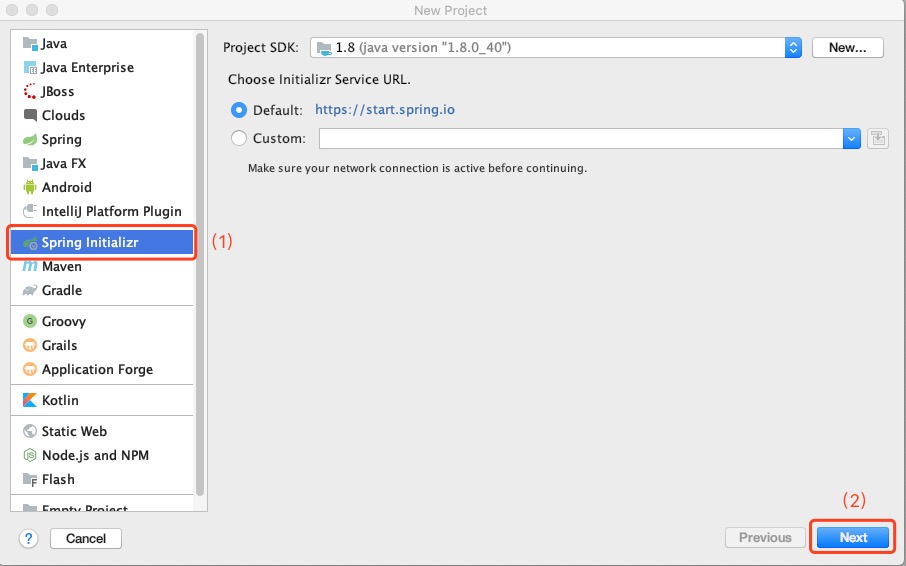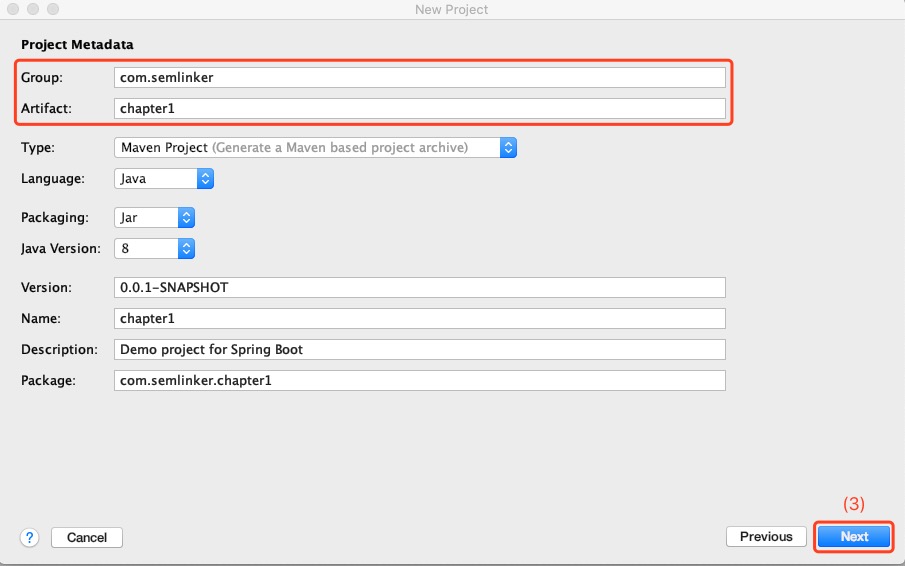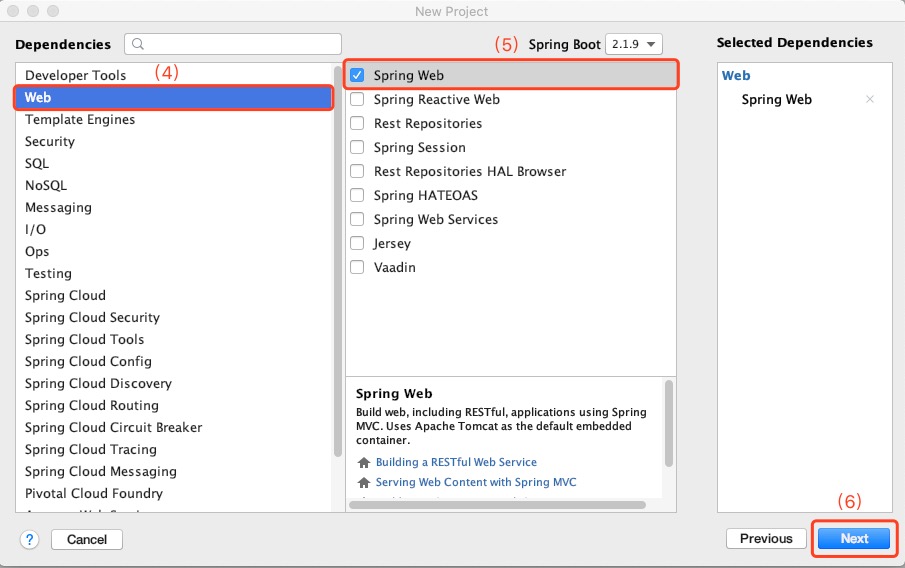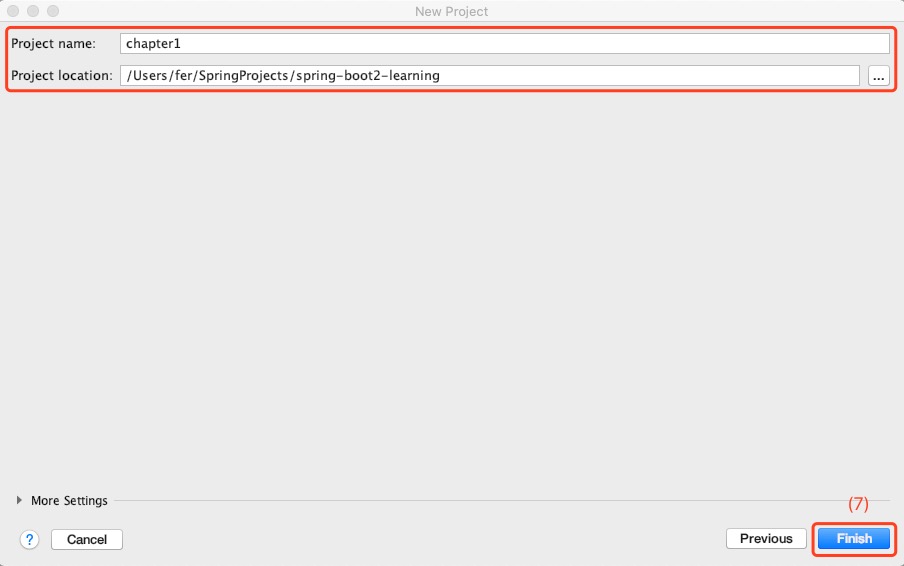Spring Boot 2.x (一):第一个 Web 应用 Hello Spring Boot 2
- JDK
➜ ~ java -version java version "1.8.0_144" Java(TM) SE Runtime Environment (build 1.8.0_144-b01) Java HotSpot(TM) 64-Bit Server VM (build 25.144-b01, mixed mode)
- Maven - 3.6.1
➜ ~ mvn -version Apache Maven 3.6.1
- IntelliJ IDEA
Spring Boot 简介
Spring Boot 是由 Pivotal 团队提供的全新框架,其设计目的是用来简化新 Spring 应用的初始搭建以及开发过程。该框架使用了特定的方式来进行配置,从而使开发人员不再需要定义样板化的配置。通过这种方式,Spring Boot致力于在蓬勃发展的快速应用开发领域(Rapid Application Development)成为领导者。
Spring Boot 具有以下特点:
- 可以创建独立的 Spring 应用程序,并且基于 Maven 或 Gradle 插件,可以创建可执行的 JARs 和 WARs;
- 内嵌 Tomcat 或 Jetty 等 Servlet 容器;
- 提供自动配置的 “starter” 项目对象模型(POMS)以简化 Maven 配置;
- 尽可能自动配置 Spring 容器;
- 提供一些常见的功能、如监控、WEB容器,健康,安全等功能;
- 绝对没有代码生成,也不需要 XML 配置。
创建 Web 项目
1、首先启动 Idea 找到 File -> New -> Project -> Spring Initializr

2、选择 Next,填写项目元信息
- Group: 组织 ID,一般分为多个段,第一段为域,第二段为公司名称。域又分为 org、com 或 cn 等等,其中 org 为非营利组织,com 为商业组织 。
- Artifact: 唯一标识符,一般是项目名称。

3、继续选择 Next,勾选项目依赖,这里选择 Web -> Spring Web

4、填写项目名和项目路径

5、最后选择 Finish,此时第一个 Web 项目就创建完成了,对应的目录结构如下:
├── HELP.md
├── chapter1.iml
├── mvnw
├── mvnw.cmd
├── pom.xml
└── src
├── main
│ ├── java
│ │ └── com
│ │ └── semlinker
│ │ └── chapter1
│ │ └── Chapter1Application.java # 项目启动类,包含main函数
│ └── resources
│ ├── application.properties # 项目主要的配置文件
│ ├── static
│ └── templates
└── test
└── java
└── com
└── semlinker
└── chapter1
└── Chapter1ApplicationTests.java
此外在根目录下还存在一个 pom.xml 文件,POM(Project Object Model,项目对象模型)是 Maven 工程的基本工作单元,是一个 XML 文件,包含了项目的基本信息,用于描述项目如何构建,声明项目依赖,等等。
执行任务或目标时,Maven 会在当前目录中查找 POM。它读取 POM,获取所需的配置信息,然后执行目标。
POM 中可以指定以下配置:
- 项目依赖
- 插件
- 执行目标
- 项目构建 profile
- 项目版本
- 项目开发者列表
- 相关邮件列表信息
了解完 pom 相关的基础知识,我们来一睹它的真容。打开项目中的 pom.xml 文件,该文件的具体内容如下:
<?xml version="1.0" encoding="UTF-8"?>
<project xmlns="http://maven.apache.org/POM/4.0.0" xmlns:xsi="http://www.w3.org/2001/XMLSchema-instance"
xsi:schemaLocation="http://maven.apache.org/POM/4.0.0 https://maven.apache.org/xsd/maven-4.0.0.xsd">
<modelVersion>4.0.0</modelVersion>
<parent>
<groupId>org.springframework.boot</groupId>
<artifactId>spring-boot-starter-parent</artifactId>
<version>2.1.9.RELEASE</version>
<relativePath/> <!-- lookup parent from repository -->
</parent>
<groupId>com.semlinker</groupId>
<artifactId>chapter1</artifactId>
<version>0.0.1-SNAPSHOT</version>
<name>chapter1</name>
<description>Demo project for Spring Boot</description>
<properties>
<java.version>1.8</java.version>
</properties>
<!-- 项目依赖 -->
<dependencies>
<!-- 默认内嵌Tomcat容器 -->
<dependency>
<groupId>org.springframework.boot</groupId>
<artifactId>spring-boot-starter-web</artifactId>
</dependency>
<!-- 测试依赖包,执行mvn package的时候,该包并不会被打入,因为它的生命周期只在test之内-->
<dependency>
<groupId>org.springframework.boot</groupId>
<artifactId>spring-boot-starter-test</artifactId>
<scope>test</scope>
</dependency>
</dependencies>
<build>
<plugins>
<plugin>
<groupId>org.springframework.boot</groupId>
<artifactId>spring-boot-maven-plugin</artifactId>
</plugin>
</plugins>
</build>
</project>
说了那么多,有些小伙伴估计已经按捺不住了,我们赶紧来启动一下我们的第一个 Web 应用。

在运行 Chapter1Application 应用后,我们将在控制台看到 Spring Boot 的启动信息:
. ____ _ __ _ _ /// / ___'_ __ _ _(_)_ __ __ _ / / / / ( ( )/___ | '_ | '_| | '_ // _` | / / / / /// ___)| |_)| | | | | || (_| | ) ) ) ) ' |____| .__|_| |_|_| |_/__, | / / / / =========|_|==============|___/=/_/_/_/ :: Spring Boot :: (v2.1.9.RELEASE) ... ... --- [main] o.s.b.w.embedded.tomcat.TomcatWebServer: Tomcat started on port(s): 8080 (http) with context path '' --- [main] c.s.chapter1.Chapter1Application: Started Chapter1Application in 1.532 seconds (JVM running for 2.045)
通过观察启动信息,我们可知 Spring Boot 默认使用 Tomcat 作为 Servlet 容器,且使用 8080 作为默认端口。小伙伴们是不是觉得入门 So easy,但当你在浏览器中访问 http://localhost:8080/ 地址,你将会看到以下不忍直视的画面:
Whitelabel Error Page This application has no explicit mapping for /error, so you are seeing this as a fallback. Sat Oct 12 12:16:49 CST 2019 There was an unexpected error (type=Not Found, status=404). No message available
从 This application has no explicit mapping for /error 错误信息中,可知是由于我们未设置 / 映射信息导致的,下面我们来着手解决这个问题。要解决这个问题,我们需要新建一个 HelloController 类,在该类下定义请求映射信息,具体如下:
package com.semlinker.chapter1.controller;
import org.springframework.web.bind.annotation.RequestMapping;
import org.springframework.web.bind.annotation.RestController;
@RestController
public class HelloController {
@RequestMapping("/")
public String greet() {
return "Hello Spring boot 2.x";
}
}
在完成 HelloController 类的定义之后,我们需要重新启动一下应用。当应用成功启动之后,我们再来使用浏览器来访问一下 http://localhost:8080/ 地址,如果不出意外的话,我们将在页面中看到预期的结果:
Hello Spring boot 2.x
常见问题
1、端口被占用怎么办
通过前面的介绍,我们可知 Spring Boot 默认使用的端口是 8080,所以如果你们本地的 8080 端口已经被占用了,那么你将不能正常启动 Spring Boot 项目。对于这个问题,我们可以通过一个简单的方式来解决,即通过配置文件 application.properties 来修改默认的端口。
server.port=8088
当修改完配置文件,重启应用的时候,在控制台可以看到以下的输出信息:
embedded.tomcat.TomcatWebServer : Tomcat initialized with port(s): 8088 (http)
这就表明我们已经成功修改了 Tomcat 默认的端口。
2、如何进行单元测试
细心的小伙伴可能会注意到在 chapter1 项目的根目录下的 pom.xml 文件中还配置了一个依赖 —— spring-boot-starter-test:
<dependency> <groupId>org.springframework.boot</groupId> <artifactId>spring-boot-starter-test</artifactId> <scope>test</scope> </dependency>
顾名思义,这个依赖就是为我们项目提供单元测试支持。
package com.semlinker.chapter1;
import org.junit.Test;
import org.junit.runner.RunWith;
import org.springframework.beans.factory.annotation.Autowired;
import org.springframework.boot.test.context.SpringBootTest;
import org.springframework.boot.test.web.client.TestRestTemplate;
import org.springframework.boot.web.server.LocalServerPort;
import org.springframework.http.ResponseEntity;
import org.springframework.test.context.junit4.SpringRunner;
import java.net.URL;
import static org.junit.Assert.assertEquals;
@RunWith(SpringRunner.class)
@SpringBootTest(webEnvironment = SpringBootTest.WebEnvironment.RANDOM_PORT)
public class Chapter1ApplicationTests {
@LocalServerPort
private int port;
@Autowired
private TestRestTemplate template;
@Test
public void testGreet() {
ResponseEntity<String> response = template.getForEntity("http://localhost:" + port,
String.class);
assertEquals(response.getBody(), "Hello Spring boot 2.x");
}
}
在 Chapter1ApplicationTests 测试类中,我们通过注入 TestRestTemplate 对象,来发送 Http 请求。需要注意的是在使用 @SpringBootTest 注解时,需要设置 webEnvironment 属性,否则运行单元测试时,会抛出异常,
详细信息可以参考 spring boot test unable to inject TestRestTemplate and MockMvc 这篇文章。
- 本文标签: 配置 模型 DOM client 端口 IO tar 领导 junit REST java 生命 servlet map springboot App build cmd plugin IDE 单元测试 插件 spring http jetty Spring Boot 安全 CTO 2019 schema 测试 bean https 开发者 JVM 组织 目录 entity pom id cat 代码 rand 开发 web message ip UI equals XML src maven MQ description API CST dependencies apache 文章 tomcat
- 版权声明: 本文为互联网转载文章,出处已在文章中说明(部分除外)。如果侵权,请联系本站长删除,谢谢。
- 本文海报: 生成海报一 生成海报二











![[HBLOG]公众号](https://www.liuhaihua.cn/img/qrcode_gzh.jpg)

